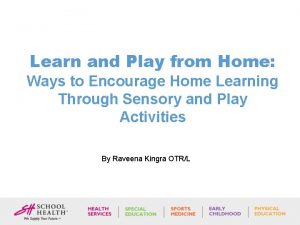12 Ways to Encourage Reading at Home 1














- Slides: 14

12 Ways to Encourage Reading at Home

1. Create a Print-Rich Environment ● Keep a wide selection of reading materials–books, magazines and newspapers ● Set up low shelves/decorated boxes that your child can reach easily, close to somewhere comfortable to sit. ● Point out letter-sound relationships to children on labels, boxes and signs. ● Know your child’s reading interests - find books that will be engaging with captivating pictures. Use a variety of everyday situations to develop children’s reading – shopping, traveling, visiting. ● Get a subscription in his or her name to an age appropriate magazine. ● When relatives and others ask for gift ideas, suggest books or bookstore gift certificates.

2. Make Reading a Ritual • Make reading a habit for bedtime, after lunch, or after naptime. • The individual attention, physical closeness and feeling of security will stimulate a child’s reading development and fuel a close relationship between parent and child. • Learning pre-reading skills and beginning to recognize letters and words.

3. Reading Aloud “Read-alouds are absolute musts! ● They allow children to simply sit back and hear the flow and rhythm and magic of good literature without having to struggle with the text themselves” (Combs, 1996, p. 144). ● Through read-alouds, ESL children are provided a ‘model of what oral reading sounds like’.

4. Discover the joy of reading books together • While you read aloud together, adjust your reading speed to the child’s pace. As the child gains fluency and confidence in reading, gradually drop out of the reading. • Discuss and make comments on the story before, during, and at the end of the reading. • Encourage prediction of story events. ● The story does not have to be completed in one sitting. ● Encourage appropriate expression, phrasing, tempo and enunciation. ● Develop your child’ confidence by giving him/her the chance to participate. ● Use a variety of books, including big books. ● An older brother or sister, relative or friend could also be encouraged

5. Engage in Partnered Reading • Read the opening sentence aloud, pause and allow the child to read the second sentence. • Continue reading alternate lines, paragraph or pages until the story is completed. • Comments, opinions and reactions during the story should be encouraged. • Run a finger under the words they are reading. The Fish who had a wish ● Using the interactive story/text copy of ‘The fish who had a wish’, take turns reading aloud. http: //www. katrinalogan. com/2014/content/fish-wish Try to: ● Encourage active listening ● Connect the illustrations as you read ● Read with expression ● Encourage prediction ● Follow with discussion

6. Use the Pause, Prompt & Praise Technique ● Pause to give your child sufficient time to try to read the word by himself/herself. ● Prompt if your child is unable to read the word. Use the picture or sound out the word to give hints. Connect it to something your child already knows. ● Praise your child for his/her efforts, regardless of whether he/she ‘gets’ the word or not.

7. Read-it again! ● Children love the predictability of familiar books. ● These are the books your child will memorize and these are likely to be the first books they will read alone. ● Show enthusiasm as you re-read your child’s favorite story/parts of a story.

8. Recite Rhymes, Poems and Songs ● Encourage children to repeat, until they know rhymes/songs by heart e. g. ‘The wheels on the bus go round and round’. ● Use pictures, objects or actions as memory joggers. ● Show them the words in print. ● Encourage children to perform.

9. Play word games ● They provide a relaxed and informal learning situation, free from tension and anxiety. ● Examples: ‘I spy with my little eye’; ‘how many words can you think of that sound like the word ‘bat’? ’; ‘complete the sentence from the story’; ‘true or false cards’; ‘spot the odd word out’; ‘word bingo’; make words using magnetic letters on the refrigerator.

10. Visit the library ● Make a routine visit to the local library ● Choose from a wide range of books. ● Find books by a particular author or on a particular topic. ● Ask the librarian to explain how to use the catalogue system. ● Join scheduled story sessions

11. Sustained Silent Reading ● An independent reading time set aside for your child to silently read/browse through self-selected books. ● Try using the “Drop everything and read” (DEAR) technique with your child for ten minutes each day.

12. Make reading fun ● Discuss exciting incidents, funny characters. ● Dramatize the story where possible, using song, mine, puppets or props. ● Personalize the story by adding children’s names ● Reading stories that excite your child. ● Make the reading session short. ● Show your own enjoyment.

Start now! The desire to read is not born in a child. It is planted by parents and teachers (Treleese, 2001). Choose one of the twelve ideas presented here that you may consider implementing in your home and thereafter recommend to other parents and friends.
 Ways to encourage reading at home
Ways to encourage reading at home Pre reading while reading and post reading activities
Pre reading while reading and post reading activities Gods ways are not our ways
Gods ways are not our ways Harmful and useful materials
Harmful and useful materials Chapter 13 section 1 changing ways of life
Chapter 13 section 1 changing ways of life Oak springs rv park
Oak springs rv park Home sweet home survive prayer
Home sweet home survive prayer South carolina mobile home parks for sale
South carolina mobile home parks for sale Let's go to my house
Let's go to my house Plurals of flower
Plurals of flower John heartfield
John heartfield Aarti home care
Aarti home care Come home come home jesus is calling
Come home come home jesus is calling She said that, home economics stands for the ideal home.
She said that, home economics stands for the ideal home. Perbedaan home care dan home visit
Perbedaan home care dan home visit



























